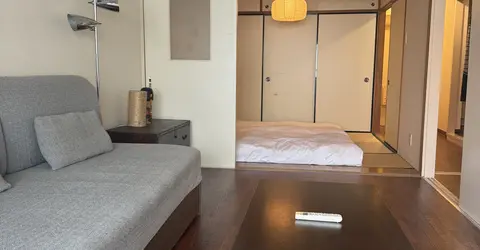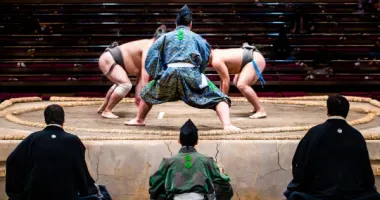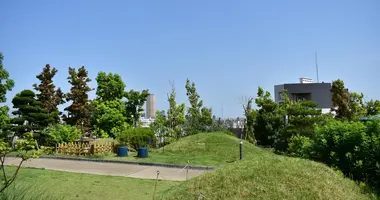Todoroki Valley Tokyo
Todoroki Valley in Setagaya south Tokyo is a area of green space with a stream, woods, Todoroki Fudoson Temple and some ancient tombs.
Todoroki Valley, Setagaya, Tokyo 等々力渓谷公園
- Tokyo's Only Unspoiled Valley
- Todoroki Ravine Third Tumulus
- Todoroki Fudoson Temple
- Fudo-no-Taki Falls
- Japanese Garden
- Access
- Nearby
- Todoroki Valley Map
- Tokyo Parks & Gardens
by Marshall Hughes
Todoroki is a valley in Setagaya ward, south-west Tokyo, near Kawasaki City. The valley, often called a ravine, flanks an approximately 700 meter stretch of the Yazawa River. Todoroki Valley belies its urban surrounds with giant trees cascading over sharply rising banks, temples and shrines dating back more than 1,000 years, and without any giant buildings rising above the trees as in many of Tokyo's parks such as Shinjuku Gyoen.
There is an impressive variety of trees here for its size, including Japanese zelkova, Japanese mountain cherry trees and several kinds of oak, offering the visitor a quiet retreat, as well as cooling shade in the hotter months. Furthermore, it is no more than a couple of minutes from a train station.
Each season affords the valley its own charms: budding spring verdancy, cooling summer foliage, rich autumn colors, and stark, bracing wintry beauty.
 Todoroki Valley, Setagaya, Tokyo
Todoroki Valley, Setagaya, Tokyo Plenty of green greets you in Todoroki Valley, Setagaya, Tokyo
Plenty of green greets you in Todoroki Valley, Setagaya, Tokyo
Tokyo's Only Unspoiled Valley
The Todoroki Valley is just three minutes' walk from Todoroki Station on the Tokyu Oimachi Train Line, then down the 50 or so steps into the valley from Golf Bashi Bridge. This bridge is named for the huge golf course that used occupy this area—the former Todoroki Village—in the 1920s and 1930s.
Todoroki Ravine Third Tumulus
Tamazawa-bashi (Tamazawa Bridge), which is part of Kanpachi-dori Street (Route 311), goes across the valley at about its halfway point. About 50 meters on after you've gone under the bridge is the Todoroki Ravine Third Tumulus. This ancient stone tomb is the best preserved of half a dozen ancient stone tombs in old burial mounds (kofun) in the area, dating from the 7th-8th centuries A.D.
 A few steps down the stairs drops the temperature three degrees
A few steps down the stairs drops the temperature three degrees Mitakesan Ancient Tomb dates from about the 7th century
Mitakesan Ancient Tomb dates from about the 7th century
Todoroki Fudoson Temple
Todoroki Fudoson Temple is 150 meters on from the stone tomb, up some steps on the left. It is a sub-temple of the nearby Manganji Temple. According to temple legend, Todoroki Fudoson's roots go back over 1,300 years. The current temple building is of considerable vintage, having been built in the mid-19th century. Todoroki Fudoson is renowned for its beautiful cherry blossoms in spring.
 Beware of the dragons on your walk
Beware of the dragons on your walk
Fudo-no-Taki Falls
The Fudo-no-Taki Falls are right near the temple. Legend has it that the name Todoroki comes from the Japanese word todoroki, which means "roar," although the kanji used for the name of the valley is different. The falls have traditionally been used for ascetic training.
 Todoroki Fudoson Temple is worth the short walk
Todoroki Fudoson Temple is worth the short walk Tempting fruit from the Japanese Garden
Tempting fruit from the Japanese Garden
Japanese Garden
The path from the temple curves to the right bringing you to the small Japanese Garden (日本庭園; Nihon Teien) with fruit hanging all around. The garden is open from 9 am to 5 pm from March to October, and from 9 am to 4.30 pm from November to February. It is closed December 29 to January 3.
 The start of the walk is under Golf Bashi Bridge
The start of the walk is under Golf Bashi Bridge Todoroki Valley Map
Todoroki Valley Map
Access - Getting To Todoroki Valley
From Gotanda Station on the Yamanote Line, take the Toku-Ikegami Line to Hatanodai.
Change to the Tokyu Oimachi Line and go to Todoroki Station. This will take you 21 minutes and cost 200 yen.
From Oimachi take the Tokyu-Oimachi Line to Todoroki Station. It is a 19-minute ride and costs 200 yen.
The valley is north of the Tama River that divides Tokyo from Kawasaki.
Open: 24/7/365, except for the Japanese Garden.
Nearby
Mitakesan Ancient Tomb, also from around the 7th century, is located to the east of the valley, specifically east of the Todoroki Japanese Gardens, on the other side of Meguro-dori Avenue (Route 312).
The Masanari Murai Memorial Museum of Art dedicated to the art of the Ogaki-born artist Masanari Murai (1905-1999) is close to the park. The museum is open each Sunday, by reservation only. (www.muraimasanari.com)
Todoroki Map
Read about other Tokyo hikes.





























